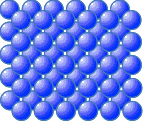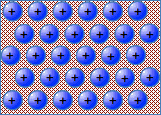|
Chemguide: Core Chemistry 14 - 16 Metallic bonding This page introduces the bonding in metals in terms of the delocalisation of electrons - often called a sea of electrons. The arrangement of the atoms in a metal There are various different ways that atoms pack together in metals, but the most efficient ones involve each atom being touched by 12 others. The diagram show the atoms in one layer of such a metal.
Focus on just one of the atoms, such as the one in black in the next diagram.
You will see that it has 6 other atoms touching it in the same layer. The next layer would go on sitting in the gaps between the atoms in the first layer - not directly on top of the first layer. The next diagram shows three such atoms. They are picked out in red just to make it easier to see.
You can see that the atom shown in black has 3 more atoms touching it in the new layer. There will also be 3 atoms touching it in the layer underneath - a total of 12 touching atoms altogether. Some metals (sodium is a good example) pack less efficiently. Each sodium atom is only touched by 8 other atoms. You wouldn't be expected to know this sort of detail at this level, and all of this is really just out of interest. In metals like sodium, none of the atoms in a layer are touching each other.
When you put the next layer on, the atoms sit in the gaps in the bottom layer. You can see that each atom is now being touched by 4 others.
The next layer goes on directly over the top of the bottom layer - there is no way I can draw this to make it clear! But once you have put the next layer on, each atom is being touched by 8 others - 4 above it and 4 underneath it. I repeat - you almost certainly don't need to know all of this. But it might be useful to know that not all metals pack in the same way. Metals as giant structures Whichever way the atoms arrange themselves, the structure goes on indefinitely in all three dimensions. If you broke the piece of metal, you would just have two smaller pieces of the same structure. What holds the atoms together in a giant metallic structure? You will know that in a covalent bond, two atoms are held together because both nuclei are attracted to the same pair of shared electrons. In metals, something similar happens - except on a huge scale. | |
|
Note: If you don't know this, it would help to read at least the beginning of the page on covalent bonding. | |
|
In a metal like magnesium (electronic structure 2,8,2), the outer electrons become delocalised over the whole metal structure. This means that they are no longer attached to a particular atom or pair of atoms, but can be thought of as moving freely around in the whole structure. A common description of this is a sea of electrons which can flow around throughout the piece of metal. Going back to the magnesium case, each atom's outer electrons are involved in this delocalisation or sea of electrons. The rest of each atom (the nucleus and the inner electrons) is essentially a magnesium ion, Mg2+. In the diagram, I have just shown these ions with a plus sign (+). How positive the ions are depends on how many electrons the atom has donated to the sea, of course.
So you have an array of positive ions surrounded by a negative sea of electrons. It is the attraction of every ion to that sea which holds the structure together. In the diagram, the sea is shown by the shaded area taking in all the atoms - and this continues in all three dimensions. Metals are often described as being an array of positive ions in a sea of electrons. You have to be a bit careful about this, though. There are going to be exactly the right number of electrons in the overall structure to counter the positive charges of the ions - so if you are writing a symbol for a metal, you always write a symbol for the simple atom rather than the ion. So the symbol for magnesium metal is Mg, and not Mg2+. What determines the strength of the metallic bond? The more chemistry you do, the more you will find that this is a tricky question to answer in general terms - there are all sorts of exceptions and oddities. But the most important factor is the number of electrons in the outer levels of the atoms which can be involved in the delocalisation. So, for example, Group 1 metals like sodium only have one electron in their outer level, and you will get a structure of 1+ ions attracted to a sea of electrons which only involves one electron per atom. In Group 2, there are two outer electrons, and the attraction will now be between 2+ ions and a sea of electrons which is twice as dense as in the sodium case. So Group 2 metals have stronger metallic bonds (and so higher melting and boiling points) than Group 1 metals. For reasons that are beyond this level, in the transition metals more electrons can be involved per atom, and so the bond is stronger still, and this is where you will find metals with really high melting and boiling points. Tungsten (W), for example, is the metal with the highest melting and boiling points, and so is the metal with the strongest metallic bonds.
© Jim Clark 2019 |
|





